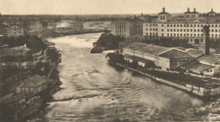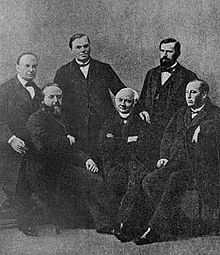Krenholm Manufacturing Company
| Industry | Manufacturing, cotton spinning and manufacturing mills |
|---|---|
| Founder | Ludwig Knoop |
| Defunct | went bankrupt in 2010 |
| Headquarters | Narva, Estonia |
Number of employees | After bankruptcy, purchased by Swedish company Prod i Ronneby AB, 500 employees in 2012 |

The Krenholm Manufacturing Company (alternate spelling, Kreenholm; German, Krähnholm, meaning "crow island") is located on the island of Kreenholm in what is now Narva, Estonia, on the border with Russia. It is situated along the banks of the Narva River, by the Narva Falls; the Baltic Sea is approximately 10 miles (16 km) away, and there is a distance of 75 miles (121 km) to Saint Petersburg. It was founded by Ludwig Knoop, a cotton merchant from Bremen. The company's cotton spinning and manufacturing mills were the largest in the world;[1] and Krenholm was considered in its time to be the most important mill in Russia, owning 32,000 acres of land and employing 12,000 people.[2] In its history, the company faced different obstacles. such as the possibility of closure after World War I. In 1994, it was privatised after Estonia regained independence. The company went bankrupt in 2010, but continued limited operations after purchase by a new owner.
History
19th century
"The whole place is a bit of England on Russian ground." (Professor Gerhart von Schulze-Gävernitz)
The Krenholm mill was founded in 1857 by the pioneer of the Russian cotton industry, Ludwig Knoop, along with Soldatenkov, and Khlyudov. [4]After the 1872 cholera epidemic which killed 420 workers, the mill's internal police force was disbanded. But when the administration reintroduced it later in the year, a strike ensued, the first major industrial strike in Estonia,[5] which became a riot, and regular troops were called in to end it. A State Commission investigated the situation, and its report concluded that work conditions had to improve and the internal police ceased to exist.[6] In 1893, it contained 340,000 spindles and 22,000 looms, requiring 6,000 horse power, and employing 7,000 people.[7] Professor Gerhart von Schulze-Gävernitz visited the mills in the 1890s stating that, "The whole place is a bit of England on Russian ground."[3]

The mill is located on an island and along the banks of the Narva River. The Baltic Sea is only about 10 miles away, and in the harbor at the mouth of the river large cotton warehouses were erected where cotton, imported directly from the United States or Liverpool, was stored and brought up the river to the mill as needed. The Narva, just before it runs into the sea, has a fall of about 27 feet which provided a source of power. The machinery was distributed through three separate buildings, of brick and stone construction, two of them being five stories and one four.The last mill, devoted entirely to spinning, was of American construction. The carding and spinning machinery was from the firm of Platt Brothers & Co Ltd, in Oldham, England. Some of the looms were English, but most of them were made by the firm in its foundry and machine works, which were an adjunct of the mill.[2]
Driving power included 11 water turbines with a combined horsepower of 8,550, and supplementary steam engines of 700 horsepower were employed. Seventy per cent of the spindles were used in making yarns for sale principally among weavers in the St. Petersburg and Moscow textile districts. A specialty of the mill was 90s ply yarn, made from Egyptian yarn, for the rubber-tire manufacturers. The range of yarns produced was wide, running from 3s to 90s, and about 330,000 of the spindles were mules. The woven textile consisted mainly of print cloth in various types of construction and sateens, both woven from 34s warp and 38s weft. Practically all the goods were shipped to a factory in Moscow, in which the firm had a large interest.[2]
The managers and assistant managers of the mills were English. The laborers were partly Russian and partly Estonian.[8] The company was active in looking after the welfare of the employees. It provided a hospital, schooling for 1,200 children, a Russian Orthodox Church (built at a cost of $250,000) and a Lutheran church (for the Esthonians). Employees lived at the mill paying only nominal rental.[2]

20th century
The wages paid in 1910 amounted to $1,370,000. In that year, 74,660 bales of cotton were used, from which 34,861,796 pounds of yarn and 159,994 pieces of cloth (average 45 yards each) were used.[9] Before the war, this mill employed over 10,000 people and manufactured yearly over 70,000,000 yards of semi-finished cotton cloth, which was sent to Russia for bleaching and dyeing, and then utilized in Russia. The Estonian cotton industry experienced a crisis after World War I which resulted in the practical closure of the mill, which at the time, was the largest mill in the former Russian Empire. The closure occurred as there was no market for this cloth due to post-war conditions in Soviet Russia.[10]
By 1944, the company was in ruins, and came under the ownership of the Soviet Union, which turned it into a large industrial enterprise, driven by policy rather than profits. In the early 1970s, the company reportedly owned 32,000 acres of land and employed 12,000 people.[9] After 1986, the company did not have to rely on approvals from the textile ministry in Moscow, and was able to export its goods using independent judgement.[11] The company was privatised in 1994 after Estonia regained independence. Its main shareholder became the Swedish company, Borås Wäfveri AB. Renamed Krenholm Group, the realignment included several production units, Krenholm Finishing, Krenholm Sewing, Krenholm Spinning, Krenholm Terry Clothes, Krenholm Weaving; a service unit, Krenholm Service; and sales subsidiaries, Krenholm Textile, Krenholm Scandinavia AB, and Krenholm Germany GmbH.[12]
21st century
In recent years, the company lost money, and was under restructuring; many employees lost their jobs. In 2003, the company was forced to fire 170 workers after the closure of its spinning facility.[13] In early 2004, the company had 4,600 workers, of which a further 400 were made redundant in April 2004.[13] There was speculation in 2008 and 2009 that the company would go bankrupt, and it eventually did in November 2010. It was purchased by the Swedish company Prod i Ronneby AB whose affiliate company in Narva, Eurotekstiil, would continue some of the operations;[14] Ithere were about 500 people employed. By 2012, the company chairman stated that it would be "absolutely impossible" restore the previous scale of operations.[15]
See also
Further reading
- (1933). 75, 1857-1932 Gesellschaft der Krähnholm Manufaktur für Baumwollfabrikate. Tallinn: Verlag der Krähnholm Manufaktur. (German language)
References
- This article includes text incorporated from United States Congress' "Congressional edition." (1912), a publication now in the public domain.
- ↑ Institution of Mechanical Engineers (Great Britain) (1899). Proceedings - Institution of Mechanical Engineers (Public domain ed.). Published for the Institution by Mechanical Engineering Publications Ltd. pp. 266–. Retrieved 29 March 2012.
- ↑ 2.0 2.1 2.2 2.3 United States. Congress (1912). Congressional edition (Public domain ed.). U.S. G.P.O. pp. 34–. Retrieved 29 March 2012.
- ↑ 3.0 3.1 Drage, Geoffrey (1904). Russian affairs (Public domain ed.). J. Murray. pp. 363–. Retrieved 29 March 2012.
- ↑ Blackwell, William L. (January 1974). Russian Economic Development from Peter the Great to Stalin. New Viewpoints. p. 132. ISBN 978-0-531-06363-7. Retrieved 2 April 2012.
- ↑ Raun, Toivo U. (2001). Estonia and the Estonians. Hoover Press. pp. 74–. ISBN 978-0-8179-2852-0. Retrieved 1 April 2012.
- ↑ Turin, S. P. (23 January 1968). From Peter the Great to Lenin: History of Russian Labour Movement With Special Reference to Trade Unionism. Psychology Press. pp. 37–. ISBN 978-0-7146-1364-2. Retrieved 29 March 2012.
- ↑ Hall's journal of health (Public domain ed.). Hall. 1893. pp. 20–. Retrieved 29 March 2012.
- ↑ Estonian International Commission for the Investigation of Crimes Against Humanity (2006). Estonia, 1940-1945: Reports of the Estonian International Commission for the Investigation of Crimes Against Humanity. Estonian Foundation for the Investigation of Crimes Against Humanity. ISBN 978-9949-13-040-5. Retrieved 2 April 2012.
- ↑ 9.0 9.1 Pollard, Sidney; Holmes, Colin (1972). Documents of European economic history: Industrial power and national rivalry, 1870-1914. Edward Arnold. p. 106. ISBN 978-0-7131-5618-8. Retrieved 2 April 2012.
- ↑ United States. Bureau of Markets and Crop Estimates (1921). The Market reporter (Public domain ed.). U.S. Dept. of Agriculture, Bureau of Markets. pp. 127–. Retrieved 29 March 2012.
- ↑ Edström, Thomas; Haimo, David & Larnefeldt, Tommy (2003). 03/ep/001/ "WHEN PLAN BECOMES MARKET - A company’s successful change. The case of Krenholm, Estonia". Linköping University. pp. 140–. Retrieved 1 April 2012.
- ↑ Hannula, Helena; Radošević, Slavo; Tunzelmann, G. N. Von (2006). Estonia, the new EU economy: building a Baltic miracle?. Ashgate Publishing, Ltd. pp. 310–. ISBN 978-0-7546-4561-0. Retrieved 29 March 2012.
- ↑ 13.0 13.1 "Krenholm plans more layoffs". The Baltic Times. 12 February 2004. Retrieved 2 April 2012.
- ↑ "Swedish Prod i Ronneby buys the last assets of Kreenholm". The Baltics Today. January 9, 2012. Retrieved 1 April 2012.
- ↑ "New Owner: Kreenholm Bought for Parts". Eesti Rahvusringhääling (Estonian Public Broadcasting). January 9, 2012. Retrieved 1 April 2012.
Coordinates: 59°21′26″N 28°11′27″E / 59.35722°N 28.19083°E